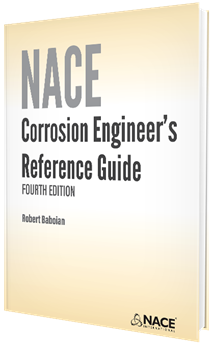THIS IS A DOWNLOADABLE E-BOOK : Open this e-book with an e-book reader.
This book documents the proceedings of the Industrial Water Treatment: Trends, Challenges, and Solutions symposium, which was sponsored by NACE International Committee STG 11 and held in Vancouver, British Columbia, Canada, from March 6 to 10, 2016, as part of Corrosion 2016. This book also includes papers presented at the Underdeposit Corrosion symposium, sponsored by NACE Committee TEG 092X. Recognized experts in their respective fields were invited to speak at the symposium, and there was particularly strong participation from representatives of academia, government, and industrial research. The symposia had two main objectives: (1) to provide a platform from which local and international participants could share the state of the art of their recent developments in water treatment chemicals, applications, challenges, and technologies, as well as to promote the exchange of information and knowledge between experts (industry and academic) and end users, and (2) to provide young researchers with professional guidance on the industrial trends, challenges, and focal areas for research in the water treatment industry and to encourage methodological rigor in research.
Consistent with the overall aim of the symposia, this book covers the scientific and technological perspectives of industrial water treatment. The book’s 27 chapters are divided into three sections. Section A (Chapters 1 through 12) deals with the formation and inhibition of scale-forming salts—including calcium carbonate, calcium sulfate dihydrate, calcium oxalate, silica, and calcium phosphate—as well as the removal of impurities and the dispersion and stabilization of suspended matter in cooling and desalination systems. Chapter 1 presents approaches to manage cooling water systems that operate under high-stress conditions attributable to makeup water contaminants. In Chapter 2, various scenarios are presented on the potential uses of recycled water for cooling water systems. Chapter 3 describes the development of a highly charged polymer for cooling water applications. Chapter 4 presents a review and data on the removal of scale-forming species by a novel electrolysis-crystallization hybrid system. The performance of polymeric additives belonging to three distinct classes—neutral, cationic, and zwitterionic—as silica polymerization inhibitors is presented in Chapter 5. The kinetics and morphological aspects of calcium carbonate crystals formed in the presence of mixed solvents is discussed in Chapter 6. Chapters 7 and 8 present results of the influence of rust particles on the performance of phosphonates as calcium carbonate inhibitors and on the formation of mixed scales (i.e., calcium carbonate and calcium sulfate dihydrate) on heated metal surfaces. The focus of Chapter 9 is on the formation and characterization of calcium oxalate crystals formed in the presence of cross-linked vinylphosphonic acid polymer. Chapters 10 and 11 deal with the stabilization and dispersion of iron oxide particles in aqueous systems by polymeric and nonpolymeric additives. In Chapter 12, the use of calcium carbonate as an adsorbent in the removal of copper (II) ions is discussed.
Section B consists of four chapters and focuses on the fundamentals of corrosion and its control in industrial water systems. Chapter 13 presents laboratory and field data on the performance of a new heavy metal–free, low–phosphorus content corrosion inhibitor for evaporating cooling systems. In Chapter 14, a discussion is presented on the chemistry and crystallographic characteristics of passive magnetite film formation on boiler surfaces. Chapter 15 provides failure analysis case histories on corrosivity, pitting tendency, and the risk associated with corrosion activity in industrial water systems. A discussion on the chemistry and performance characteristics of boiler water treatment polymers follows in Chapter 16.
Section C comprises 11 chapters (Chapters 17 through 27) and deals with scale formation, inhibition, challenges, and limitation in the oil and gas industry. The discussions cover conventional scale to exotic scale (e.g., iron sulfide) from conventional and unconventional resources, such as scaling in shale gas field. Chapter 17 presents guidance and limitations in selecting the proper scale inhibitors for common field applications. Chapter 18 develops scale and corrosion risk-mapping processes and derives the chemical treatment priority for shale gas fields. In Chapter 19, the implications of inhibitor molecular structure on barium sulfate crystal growth and inhibition are addressed. Chapter 20 describes the effects of Fe2+ on the performance of scale inhibitors for carbonate and sulfate scales. The focus of Chapter 21 is the difference in the risk assessment of calcium carbonate scaling between thermodynamic scale prediction and kinetic laboratorial study. Chapter 22 presents the challenges and limitations of developing scale dissolvers for iron sulfide scale in sour gas wells. In Chapter 23, a kinetic study of barium sulfate in the absence and presence of scale inhibitors, both in bulk precipitation and on surface deposition, is presented. Chapter 24 introduces a systematic experience scale study, which bridges laboratory and field data and looks at scaling deposited on engineered surfaces. In Chapters 25 and 26, the kinetics and mechanisms of calcium carbonate growth at different saturation values in the bulk and on surfaces have been addressed. Chapter 27 provides a test protocol to rapidly screen large numbers of scale inhibitors for anhydrite inhibition during steam flooding.
This book is intended primarily for scientists, researchers, technologists, and engineers working in the water treatment and water purification industries around the globe. Researchers in other industries—such as pharmaceutical, medical, and food—who are involved in the use of high-purity water, as well as those in academia, will also find useful information here.
2017 copyright, 452 pages, soft bound, 8.5" x 11"




